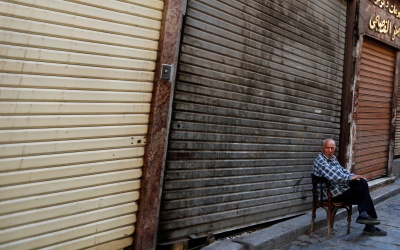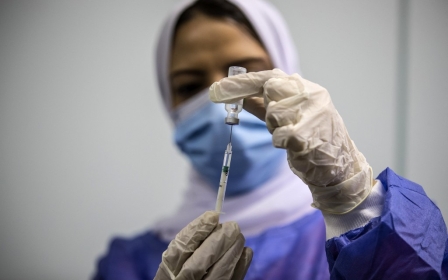Egyptians fearful over Sisi's latest economic reforms

Egyptians are bracing themselves following the announcement by the government on 28 April that it is to launch the second phase of its economic reform programme, which started in 2016.
The announcement of a fresh package of economic reforms has instilled fear in many ordinary Egyptians, who have been ill-served by the economic measures implemented by President Abdel Fattah el-Sisi over the past five years.
The new package of reforms, the government said, would be applied over the next three years.
'The problem is that the poor and the middle class always bear the brunt of most of these reforms'
- Ahmed Farghali, Egyptian MP
It noted that the second phase would address structural problems in the Egyptian economy and build on the gains of the past period.
This package of reforms will focus on specific sectors of the economy on the road to creating sustainable growth and getting over the economic shocks induced by the Covid-19 pandemic, the government said.
New MEE newsletter: Jerusalem Dispatch
Sign up to get the latest insights and analysis on Israel-Palestine, alongside Turkey Unpacked and other MEE newsletters
It added that the reforms would seek to raise the annual economic growth rate to between 6 and 7 percent in the next three years, and reduce the budget deficit to 5.5 percent from 7.7 percent now.
The reforms would also seek to achieve an initial budget surplus of 2 percent and a balance of payments surplus between $3bn and $5bn by the end of the new phase.
Despite popular concerns, the government said the new reforms would not entail additional financial pressures on ordinary people.
Prime Minister Mustafa Madbouli assured the public that the government would maintain food subsidies, and spending on health, education and social welfare in the next three years.
However, there is little confidence on the streets about the implementation of the new reforms and whether they would bring hardship to millions of people.
"I don't trust any talk about the reforms not adding pressures on the people," pensioner Mahmoud Hussein told Middle East Eye. "The same promises were made ahead of the previous reforms, and they brought nothing but hunger and poverty to the people."
Pressures on the middle class
The first phase of the economic reform programme was implemented on 3 November 2016. It included the shock decision of liberalising the exchange rate of the Egyptian pound against all foreign currencies.
The same phase included the slashing of fuel, water and electricity subsidies, the introduction of new taxes, including a value-added tax, and a loan of $12 billion from the International Monetary Fund.
Before the government took the decision to liberalise the exchange rate of the pound, importer Suleiman Ahmed had 160,000 Egyptian pounds ready for exchange for US dollars for a shipment of leather products from China.
Ahmed was going to swap this amount of money for $20,000 at the exchange rate of the dollar at the time, which was the price of the shipment. That was on 2 November 2016.
'These reforms weakened people's purchasing power and consequently caused suffering to everybody'
- Alia al-Mahdi, professor of economics at Cairo University
Ahmed, in his early 40s, went to the bank on the following day to swap the pounds for the dollars. He was stunned to know that he needed double the amount of pounds to get the same amount of dollars, since the liberalised rate of the pound had seen its value fall by half against all foreign currencies. People like Ahmed lost half of their savings or capital.
"It was a bitter experience, portending the tough days ahead for everybody," Ahmed told MEE. "Traders like me just had to pay two times the amount of money they used to pay to get the same amount of goods."
The loss to less moneyed Egyptians like Hussein was even bigger, as commodity prices shot up, dwarfing the income of tens of millions of people and driving millions of other people below the poverty line.
The first phase of the reforms was hard on the pockets of ordinary Egyptians.
The slashing of fuel subsidies affected commodity prices across the board, creating suffering for ordinary people, especially those with limited income.
"These reforms weakened people's purchasing power and consequently caused suffering to everybody," Alia al-Mahdi, a professor of economics at Cairo University, told MEE. "Some people became just incapable of affording their basic needs."
The salaries of most Egyptians remained the same while commodity prices continued to shoot up. This made the little money most people had in their hands rarely match the prices of goods on the shelves in grocery stores nationwide.
Egypt's poverty rate surged to 32.5 percent in 2017 from 27.8 percent in 2016, throwing light on the deep effects the reforms had on the welfare of the people.
Egyptian authorities countered these effects by targeting more funds to social welfare programmes, including by offering cash aid to widows, divorced women and poor senior citizens.
"Nevertheless, the same programmes excluded those within the middle class," al-Mahdi said. "This increased pressure on this class and put it in danger."
Despite this, the government argued that the same reforms rescued the overall economy.
"The first phase of the reforms succeeded in fulfilling its own goals," Madbouli said on 28 April. "It primarily addressed financial and monetary problems in the economy."
The reforms raised the economic growth rate to 5.6 percent in the fiscal year 2017-18, from 2.9 percent before they were applied. The inflation rate dropped to 4.3 percent in September 2019, from 34.2 percent in the same month in 2017.
The unemployment rate came down to 7.5 percent in the second quarter of 2019, from 12.4 percent in the corresponding quarter in 2016. Foreign currency reserves also rose to $45bn in September 2019, from $13.4bn before the reforms were applied.
Macroeconomic growth
"Nobody can deny that these reforms improved economic indicators greatly, brought the budget deficit down, increased foreign currency reserves and blew new life into all sectors of the economy," independent economist Bassant Fahmi told MEE. "These reforms were necessary."
The government said the new phase of the reforms would include the introduction of structural adjustments to some sectors of the economy.
This, it added, is important for creating sustainable growth.
It noted that the new phase will seek to liberalise trade, reform the national vocational training system, modernise the stock exchange and the Egyptian labour market.
The new phase of the reforms, Madbouli said, would target the supply side of the economy.
"This is the first time we focus on this side, years after we focused on the demand side only," the prime minister said.
He noted that the same phase would target specific sectors of the economy, including the communications and information technology sector, the industrial sector and the agricultural sector.
These sectors contribute around 26 percent of Egypt's gross domestic product. This is why economists point to the importance of addressing the problems facing these sectors for a better performance of the economy.
"These sectors contribute almost a third of the GDP," Fahmi said. "They can become the driving force of economic growth in the coming period."
Covid-19 woes
Economists also refer to the importance of the new package of reforms, given the losses Egypt sustained because of Covid-19.
The pandemic cost Egypt dearly in economic terms. It brought the economic growth rate down to 2 percent from 5.6 percent. The pandemic also froze the tourism sector, slowed down Egypt's foreign trade and derailed the industrial sector.
An economic stimulus plan that was part of the national response to the pandemic included billions of Egyptian pounds in cash support to unemployed Egyptians and those whose livelihoods were affected by Covid-19. The same plan also included billions of pounds in tax exemptions.
The government specified $6.4bn for the national response to the pandemic. This money also included support to several economic sectors, such as the tourism sector where tens of thousands of workers lost their jobs.
The Egyptian government also had to increase borrowing, including by issuing foreign currency bonds in the international market. Foreign debts rose by $12.7bn in the first nine months of 2020, raising overall foreign debts to $125.3bn.
According to economists, this makes the fresh package of reforms even more important.
However, there is concern among the same economists that the same reforms would come at the cost of the economic welfare of the general public.
"The problem is that the poor and the middle class always bear the brunt of most of these reforms," Ahmed Farghali, a member of the parliamentary Committee on Economic Affairs, told MEE. "This is why I expect the new wave of reforms to be accompanied by a fresh package of taxes that exhaust the public even more."
Middle East Eye delivers independent and unrivalled coverage and analysis of the Middle East, North Africa and beyond. To learn more about republishing this content and the associated fees, please fill out this form. More about MEE can be found here.







